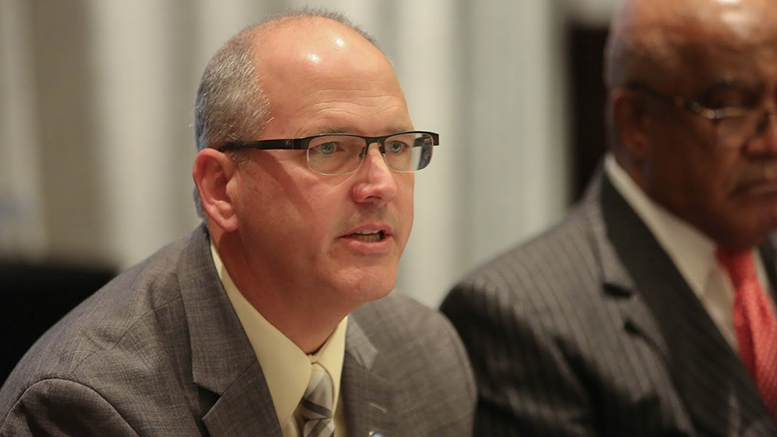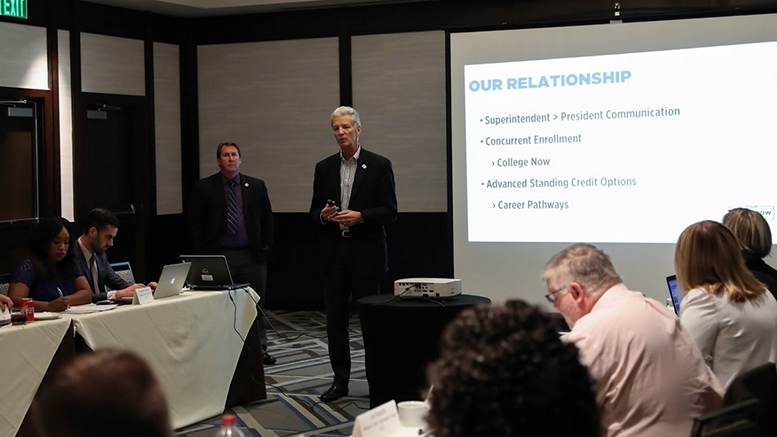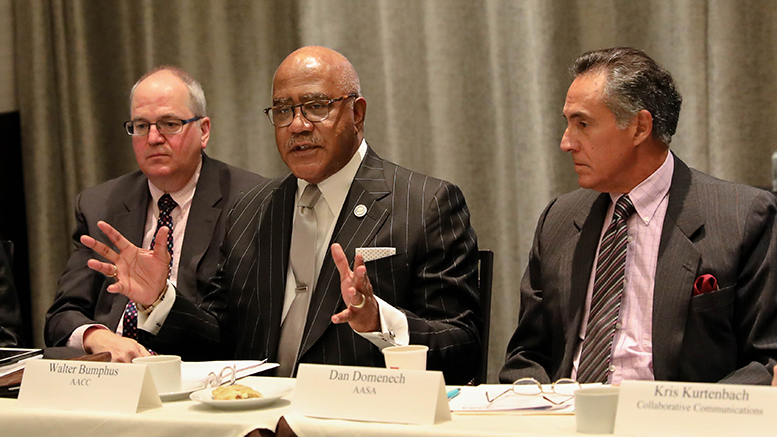Community college and school district leaders are collaborating more than ever, judging by huge increases in dual enrollment in recent years.
Thirty percent of community college students are in dual-enrollment programs, according to Walter Bumphus, president of the American Association of Community Colleges (AACC), who was one of the participants at the semi-annual meeting Sunday and Monday between members of AACC and AASA, The School Superintendents Association.
In fact, dual enrollment has helped to sustain many community colleges that are experiencing drops in enrollment because students are opting to work in the strong economy instead of attending college, Bumphus said.
K-12 leaders support dual enrollment because the programs help students experience college, explore career options and earn college credit. They also expose students to less-expensive postsecondary options to four-year colleges and universities, which is particularly attractive when faced with growing college costs and student debt.
Dual enrollment also offers a pathway to college for students in high-poverty areas where youths don’t traditionally pursue higher education. As a result, “we can be that entity that moves our students away from having a zip code define their future,” Bumphus said.
Facing reality
Since AACC and AASA began collaborating in 2014, there’s been a change in the culture, said Dan Domenech, executive director of AASA. K-12 leaders are more open to providing opportunities for students to explore community colleges and other postsecondary options, as less than 40 percent of high school students end up with a four-year degree.
Without a clear pathway to a good job, many students in “the other 60 percent” category end up with no degree and significant student loan debt, said Scott Stump, assistant secretary for career, technical and adult education at the U.S. Education Department.
“We need to make a different promise to them,” Stump said, to educate them about their pathway choices and give them more information to make good decisions. He pointed to the department’s new financial aid mobile app as a step in the right direction.
Parents need to understand that a bachelor’s degree is not for everyone and that “community colleges are a valid choice,” Stump said.

Scott Stump of the U.S. Education Department discusses options to fund dual enrollment as well as the importance of career exploration prior to college.
Paying for it
In response to a concern from Gwendolyn Shannon, schools superintendent in Southampton, Va., that dual-enrolled high school students in her state now have to pick up half the cost of community college tuition, Stump suggested using federal Pell grants for dual or concurrent enrollment. But AACC’s Bumphus cautioned that some college leaders oppose allowing high school students to tap Pell funds, as they have a limited time to use the grants. As a result, students could use up a lot of their federal student aid eligibility before they even go to college.
Stump also called for states to rethink how they split secondary and postsecondary education funds. And he encouraged K-12 students to explore career options before going to college through opportunities such as work-based learning programs and summer jobs.
“Every student should leave high school with a plan,” Stump said.
Collaboration in El Paso
In Texas, there’s been a huge increase in dual-enrollment students since El Paso Community College (EPCC) and the Socorro Independent School District started collaborating several years ago.
By 2015, there were 6,800 students in dual-credit programs. The school district has three early college high schools and plans to create three more, said Socorro Assistant Superintendent Carmen Crosse.
There are several models in El Paso, said Margie Nelson Rodriguez, special projects assistant for the vice president of instruction and workforce education at EPCC. Some students take dual-enrollment courses at their high school; others are bused to the college where they attend classes with college students.
Dual-credit students have free tuition if they take classes within their degree path, Nelson said. The school district covers the cost of textbooks and transportation.
Related AACC/AASA stories: Exploring career options earlier and Promise for apprenticeships?
Students complete that program with an associate degree as well as a diploma, many of them as high school juniors.
“If they do that, they’re not going to sit out a year,” so the University of Texas at El Paso established a scholarship program allowing those students to take up to nine credit hours toward a bachelor’s degree, said Ivette Savina, assistant vice president for outreach and student success at the university. There are 1,129 students currently in that category.
Dual-credit students tend to have higher grade point averages than other students at the university, Savina said. They also come with “a sense of self agency, self-advocacy, critical-thinking and problem-solving skills.” And they are also more likely to finish a bachelor’s degree in four years or less.
High school teachers who lead dual-enrollment classes attend professional development sessions at EPCC. So far, 50 high school teachers have earned credentials to teach high school courses.
A conveyor in the community
Wayne Burke, superintendent of Spring Hill Unified School District in Kansas, previously knew of Johnson County Community College (JCCC), but he didn’t have a relationships with its president. That changed when Joe Sopcich arrived six year ago. Not only did Sopcich visit every high school in the county, he also asked how the college could help them.
Since then, Burke and other superintendents in the county have not only increased dual enrollment — 20 percent of enrollment at JCCC comes from concurrent enrollments — but they also are trying to increase career and technical education (CTE) in the area. That hasn’t been particularly easy in the affluent county, where trade industry jobs still have a perceived stigma.
But the educators are busy showing to residents and officials the importance of CTE, especially when it comes to developing the local economy. Burke noted that there are currently about 10,000 jobs available in the area with starting salaries ranging from $30,000 to $50,000. Another 17,000 jobs are expected when baby boomers retire in the next few years.
A skilled workforce also is critical to drawing new employers to the area — such as AGC Flat Glass North America, which is looking for employees with skills in welding, auto tech and fabrication — and Garmin, which develops GPS navigation and wearable technology. In both cases, the companies look to JCCC to help train potential employees.

Joe Sopcich (center), president of Johnson County Community College in Kansas, and Wayne Burke (left), superintendent of Spring Hill Unified School District, outline their partnership.
Partnerships to reduce college costs
In Ohio, Lorain County Community College (LCCC) has worked over the years to create a pathway that goes from dual enrollment through a baccalaureate, saving students potentially tens of thousands of dollars, said Tracy Green, vice president for strategic and institutional development at the college. Ten years ago, LCCC started an early college high school that served students in financial need and underrepresented students, and it also began to partner with four-year institutions in the state to offer baccalaureates on its campuses.
In 2014-15, LCCC joined the state’s College Credit Plus program, which encouraged high school students to earn 15 to 30 college credits at no cost to them. From there, the college linked that program with its University Partnership program to create MyUniversity, which allows students to simultaneously earn a high school diploma and associate degree, as well as earn a bachelor’s degree by age 20 to prepare for careers in high-demand, high-paying jobs. (The program can also save students up to 80 percent of the cost of a baccalaureate.)
LCCC’s latest addition is to offer a applied bachelor’s degree on its own, costing students a total of $15,000 for the four-year degree in selected fields, Green said.
She hopes community colleges in Ohio and across the U.S. can better leverage their K-12 and four-year institution partnerships to streamline the postsecondary process for students, from academics and skills training, and keep costs low for students.
“There’s a wealth of opportunity if we just look at it differently,” Green said.

